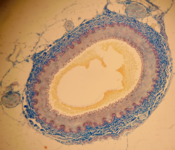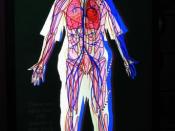Vertebrates have a closed circulatory system. Closed circulatory systems have the blood closed at all times within vessels of different size and wall thickness. In this type of system, blood is pumped by a heart through vessels, and does not normally fill body cavities. Hemoglobin causes vertebrate blood to turn red in the presence of oxygen; but more importantly hemoglobin molecules in blood cells transport oxygen. The human closed circulatory system is sometimes called the cardiovascular system. This closed system is what helps humans living on land.
The circulatory system assists with homeostasis by transporting oxygen, carbon dioxide, nutrients, waste products, immune components, and hormones. Major organs include the heart, capillaries, arteries, and veins. The lymphatic system also transports excess fluids to and from circulatory system and transports fat to the heart.
Every life must have a continual supply of energy or it will die. The vertebrate cardiovascular system includes a heart, which is a muscular pump that contracts to propel blood out to the body through arteries, and a series of blood vessels.
The upper chamber of the heart, the atrium, is where the blood enters the heart. Passing through a valve, blood enters the lower chamber, the ventricle. Contraction of the ventricle forces blood from the heart through an artery. The heart muscle is composed of cardiac muscle cells.
The circulatory system functions in the delivery of oxygen, nutrient molecules, and hormones and the removal of carbon dioxide, ammonia and other metabolic wastes. Capillaries are the points of exchange between the blood and surrounding tissues. Materials cross in and out of the capillaries by passing through or between the cells that line the capillary. Hemoglobin molecules in blood cells transport oxygen.
Circulation of the blood moves blood to a site or sites where it can be...


